Trekmates Flameless Cook Box: £30
Trekmates Flameless Cook Flask: £20
Super Power Heatpack (x5): £10
High Power Heatpack (x7): £10
A colleague described once walking on to a campsite to be greeted by the sight of a tent in flames like a jubilee beacon – testament to the hazards of using stoves under canvas.
There is also the less obvious danger from carbon monoxide, and there have been well reported cases of campers suffering from the effects of this toxic, invisible gas when burning fuel in the confined space of a tent.
So a cooking set that doesn’t use combustion is of interest from a safety point of view.
Trekmate’s Flameless Cook System uses a chemical reaction to produce heat with which to cook your camp food, so no blazing flysheet and no invisible killer gas.
Although the company isn’t giving away the formula for its heatpacks, it’s likely that it is based on calcium oxide, which when mixed with water produces heat and calcium hydroxide.
That heat, Trekmates claims, will warm your food to 90C and last for long enough to cook a camping meal and warm up a drink.
The system has two components, sold separately: the cooking box for food and a flask in which to warm your drink.
Trekmates supplied us with both to test, and we headed out on a cool afternoon to dine alfresco.
The box has a plastic outer, with a removable and washable Neoprene sleeve and an inner, stainless steel container.
We used a standard dehydrated pasta meal and put the usual amount of water in the meal, gave it a stir, then unwrapped one of the Trekmates Super Power Heatpacks.
The company recommends the Super Power packs for cooking food such as pasta and its graphs claim a temperature of 80C within 10 minutes, rising to 90C lasting for 30 minutes.
The Flameless Cook System comes with a measuring bottle for the right amount of water to add on top of the heatpack.
The pack is placed in the bottom of the outer box, the measured 120ml of water poured on to the pack, then the inner metal box containing the food is placed into the box on top of the Power Pack.
A plastic lid with clasps on four sides seals the Cook System and then you just sit and wait.
Within a few minutes there was steam coming from the box – a good sign – so we set to making a hot chocolate drink with the flask.
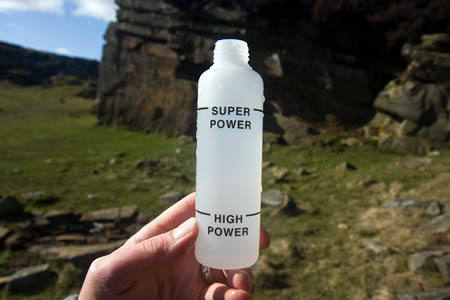
The system comes with a measuring bottle to ensure the right amount of water is placed on the Heatpacks
A High Power Heatpack is placed in the bottom of the outer container of the flask, which again has a Neoprene sleeve, and the measured 40ml of water poured in. The Super Power Heatpack should not be used with the flask.
We put our water into the inner flask container and sealed the lid.
After a few minutes the water was warming up and within 10 minutes or so it was hot enough for us to put our hot chocolate powder in.
A quick stir and then the lid went back on.
The flask has a spout that can be closed and the fact that the power pack continues to provide heat around the drink, coupled with the fact it has a sealed lid, means the liquid stays hot – very hot in fact – and care is needed not to burn your mouth if you gulp it down.
After 20 minutes it was clear our pasta was not ready to eat and it occurred we had made the mistake of putting too much water in our food. Normally, in a pan – even with a lid on – much of the liquid boils off on a conventional stove.
But in the Flameless Cook System, the sealed cooking box keeps all that moisture in and, coupled with the fact the food never quite bubbles up to boiling point, meant our pasta still had too much liquid in it.
A quick tip-out of much of the liquid and another heatpack in the bottom of the box and we were off cooking again. This time within a few minutes, the meal was ready and it was then just a case of taking off the lid and eating out of the container, with the Neoprene outer sleeve insulating enough to make it comfortable to hold.
No fiddly handle to keep attached to a pan as you might experience with a conventional stove. Another advantage is that the Cook Box keeps your food warm as you eat.
The drink also stayed hot, not just warm, all the way through.
We stuck to drinking out of the spout because, taking the lid off and drinking from the lip of the flask might, we thought, have allowed some of the cooking liquid to seep out of the outer container as we tipped it up, though there was actually no evidence of this happening.
So, with a little experimentation, using less liquid to cook than normal, we eventually had a nice hot meal, properly cooked through.
With a little forethought, it should probably have been obvious that the cooking liquid would not evaporate from a sealed box and that we needed to adjust the amount of water added.
We’ll know next time.
So, with a little adjustment to normal cooking techniques, the Flameless Cook System proved simple and safe to use.
Trekmates say the Heat Packs should be disposed of as normal household waste, so if wild camping, your will need to carry out the used packs.
How does the system compare with a conventional stove for price?
The Flameless Cook Box retails at £30, including two Heat Packs of each size, to get you started. Replacement Super Power Heatpacks cost £10 for five packs, so to cook, say 10 meals would cost a little under £50.
A conventional lightweight gas stove plus a gas canister is likely to set you back around £75 or more, so the Trekmates system compares well.
The more fuel you have to buy, the less advantage, perhaps, but for an occasional user, the economics look good.
Trekmates also offers a voucher scheme whereby points can be redeemed from Flameless Cook products to obtain, for instance, free Heat Packs, which will reduce the overall cost slightly.
The Cook Box weighs in at less than 500g too which, when compared to the weight of a stove, gas canister and pan in a conventional system, is not going to add to a backpacker’s burden.
For youth groups the benefits are obvious, with two of the main camping hazards dispensed with – just don’t spill your hot food down your front.
In bad weather or cold conditions, the Flameless Cook System just steams away nicely in the tent, with no worries about anything catching fire – plus, there’s no need for matches or lighter.
As one grough reader commented, if you need to melt snow for your water, you might struggle, but in all other conditions: wind, cold, wet, as well as more benign conditions, the system works well.
More details of the Trekmates Flameless Cook System are on the company’s website.
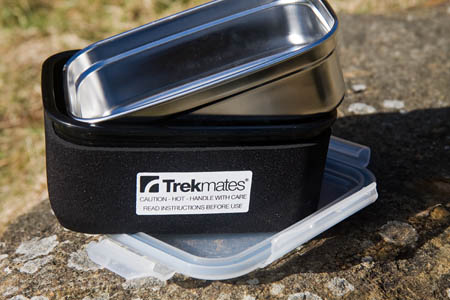
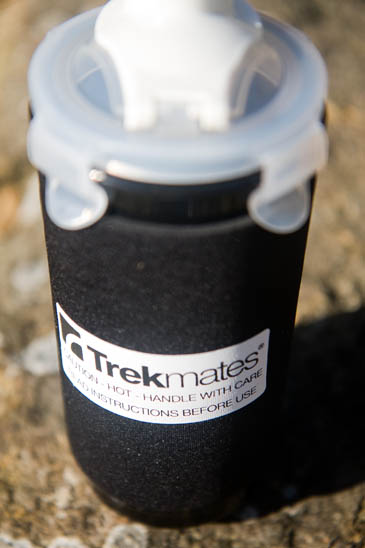
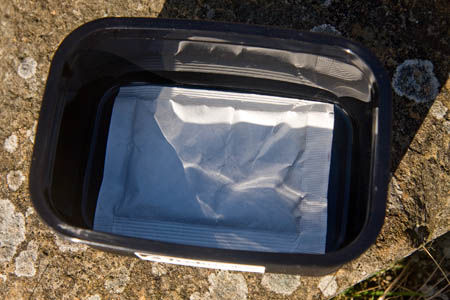
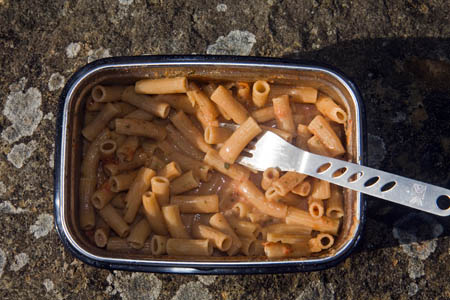
Stuart
12 April 2012Hi, we have actually had the cook set tested down to -37C in Northern Sweden and specifically asked for a test on melting snow.
Air temp was -7C and snow temperature was -12C. In these condition it melted a full container of snow down to water in just over 3 minutes.
Stu
Trekmates
Kai Jokela
03 July 2012I bought gas canister stove from Ebay for 10 euros and the canisters I use with adapter cost less than two euros a piece... of course Cooking with gas has to be done outdoors. For hostel rooms etc I use immersion coffee cup heater.
Ash
18 July 2012Just bought one of these for my weekend trip to the lakedistrick, but I couldn't resist giving it a go today. And I must say this is a very neat bt of kit.
I cooked a tin of sausage casarole using the high power heat pack and within 15mins it was walmed through to a very high temperature. However I would think next time I will use the super power heat packs as they are a bit faster (10mins).
I am looking forward to using it on my upcoming trip to the lakes, especially if its raining and I fancy a nice hot brakfast.
The best thing about this cook system is it actually works as it says it should. I am very happy with it, well done trekmates !
NotBearGrylls
30 August 2012Here's another review with the Flameless in action!
Check it out - www.youtube.com/watch?v=sApv-rPk-Mk
- NotBearGrylls
J Hogarth
02 October 20121 heatpack costs £2. meths to do the same on a trangia would cost about 10p.
penny pincher
12 October 2012Nice idea, shame about the heat pack prices....for that reason I'm out!
Squidfish
22 November 2012I just got one of these, haven't used it yet, but first impressions are it looks simple and well made. A little more info:
The big heat packs cost £2 each if you buy them from trekmates... but shop around and you can find them for a bit less. (eg. GoOutdoors do them for £9 for 5) And there is a good voucher system so you can get free / cheaper heatpacks - buy the cookbox and one pack of heatpacks and you have enough vouchers for another pack of heatpacks.
Also, the smaller heatpacks are just over £1 (7 for £9).
So, still not cheap compared to meths, unless you factor in the discomfort of cooking outside when its freezing / raining, or the tent you set fire to accidentally when cooking inside.
I have camped in some godawful conditions, and cooking in the entrance of my quasar scares the bejesus out of me every time. I REALLY like the idea of safe cooking in a tent - if this thing works well, it will be replacing my Trangia on winter camps.
Squidfish
18 February 2013OK, I have now used this now in sub zero temperatures a few times, wild camping in the Peak district, and it does perform very well. If you use the cookbox, one high power pack is enough to cook a one person dehydrated meal - best I have tried so far are from Fuizion Foods (not a typo) - meal weighs just 110g dehydrated. Put the dried stuff and 300ml water into the cookbox, set your alarm for 15 mins. It meant I could set my food cooking and get on with other stuff. Also didn't need to have door between tent and porch open while it cooked, which made a BIG difference to temperature in the tent! And it weighs about the same as my trangia mini.
The flask weighs same as my camping cup (200g according to my scales) so will be taking that next time too. I have found the water doesn't quite get hot enough to pour on a freeze dried food meal, but it is great for a hot cup of tea/coffee/chocolate. Sure, meths for my trangia is cheaper, but the way I look at it is that it costs about the same as a drink bought from a cafe...
ps. I am not affiliated with trekmates in any way! Just appreciate good gear.
madjax
17 March 2013Hi,
Can anyone tell me how many redemption points you get for each of the products and refill packs please?
Thanks for your help?
Emmanuel
27 March 2013I just redeemed 15 points for 7 high heat packs. They arrived within two days! Super service.
Has anyone taken these on a plane to go abroad? Any problems with them getting through security?
Brainspiller83
21 May 2013I have found the high power heat packs on a few websites for £7, which I snapped up straight away. I bought the flameless flask and have only used it 3 times so far. I was very impressed and that even after an hour the contents were still hot. If the packs were cheaper I would consider using it for work. But at the moment I only plan to use it for music festivals. These certainly would come in handy.
I was so impressed I may consider buying the box as well.
John McLean
02 January 2014Trekmates flameless cook box.
I travel around in a mobile clinic and thought this would be useful for heating MRE type food or home made chilli and curry. I was a bit dubious that the food would be hot enough. However so far I have been very impressed. I have only used the smaller 'high power' heat packs so far. The food gets so hot I have to blow on each fork full. The box keeps on heating the food as you eat so the meal stays hot right to the end. The reward points system helps to reduce the cost of heat packs.
J.Gater
10 February 2014Hi,
great alternative cooking meth that I would be interested in for day hikes, for a nice hot lunch and brew stops.
The only reason at the moment I would not purchase one of these units is the prohibitively expensive cost of the heat packs, for me anyway.
I wonder how many of these flameless cook boxes will end up pushed to the back of a cupboard after the first few uses, only time will tell.
Approx £1.40 every time I want to boil up some water, no thanks.
Taz
02 August 2015I've used the flask many times now, mostly in winter when reaching a summit, it does what is promises.
I bought a 'box' of a friend and used it 3 days remote wildcamping. It performed well, I forgot the water container so guessed the amount of water to add to the heat pack. Also you have to be careful not to add too much water to your food. I cooked pasta and porridge, both tasted fine. I would leave the box to cook the food and set up camp. By the time camp was organized the food was ready. The only real problem is having to carry out used wet heat packs. I can see some people hiding these under a rock.
Lauren
08 February 2017You all say about pasta and porridge; foods you'd normally cook with water but there is nothing about burgers etc? Does it work for all food cooking or just those that use water?
AGW
05 August 2017Well on consideration of everyone's comments I'm going to take the plunge and buy one to try. For some years I've used flameless cooking pouches insulated in my 'homemade' cookers fashioned from foil backed sleeping mats and Ductape. Time to try the pro version.
Katie
05 February 2019Can you cook hydrated meals with this cooker?